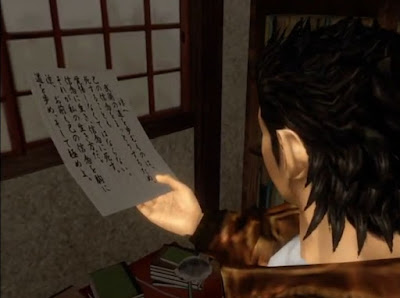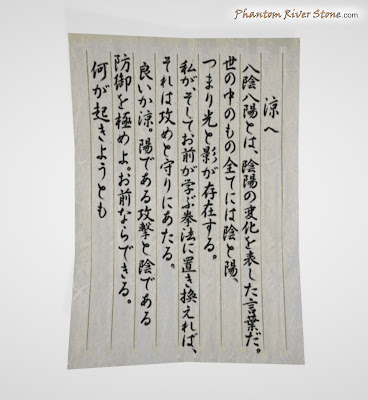In the first Shenmue game, players discover a note addressed to Ryo from his father Iwao, who seemingly had some inkling that his life was in danger. Reading through this letter is a memorable moment for players of the game.
In fact, it turns out that this is not the only that letter Iwao wrote. There is a second, unused version of Iwao's letter to Ryo that can be found within the game files which we will examine in today's post, and see how it compares to the one used in the game.
Iwao's Letter #1 (Release Version)
In Iwao's letter that Ryo finds in the game, his father gives him advice on being true to one's convictions:
"Dear Ryo... those who follow the path of a warrior, must be prepared to die in order to stand by their convictions. Live for one's convictions, die for one convictions. That is how I lived my life. Ryo, it is up to you to discover your path and follow it through."
 |
| Letter from Iwao #1 (release version) |
 |
| Ryo reading Iwao's letter (release version) |
Iwao's Letter #2 (Alternative Version / Unused Asset)
Among the game files lies a second letter from Iwao to Ryo, one that is not seen during the game. It shares the same underlying object filename (MALS530G):
 |
| Letter from Iwao #2a (unused asset) |
There is also a variant of this second letter to be found only among the files on the What's Shenmue demo disc (MALS503G). The text content is the same, but the page has more lines and a more business-like font:
 |
| Letter from Iwao #2b (What's Shenmue variant) |
 |
| Screen grab from the What's Shenmue promo VHS |
The content of this second letter is quite different from the first. It reads as follows:
"Dear Ryo... 'The Eight Principles of Yin and Yang' is a term that describes how yin and yang change. Everything in the world has yin and yang, or light and shadow. Translating it into the martial arts that you and I study, it represents offense and defense. Is that clear, Ryo? Master attack, which is yang, and defense, which is yin. You can do it. No matter what happens."
In this letter, rather than focusing on Ryo's inner beliefs as in the released game, here Iwao talks on a grander scale about the balance of the universe; including between good and evil. He makes a comparison to martial arts to better illustrate his point.
The phrase quoted by Iwao, "The Eight Principles of Yin and Yang", is written as 八陰八陽 in Japanese / Chinese.
Japanese fan も_なお Mo_Nao analyzes the meaning of this phrase in this tweet, in more depth. She gives one possible way to interpret this phrase as "Always think about the balance of everything; what you are missing and what you want to be".
This phrase has strong connections to certain characters in both the first and the second game.
Iwao Hazuki
In the first game, it can be seen in the Hazuki Dojo, where it is displayed in calligraphic writing; it also hides a certain mysterious martial arts related item behind it, for players who choose to investigate.
 |
| In the Hazuki Dojo (Shenmue) |
Yuanda Zhu
This same calligraphy can be seen again in Shenmue II, in the Five Stars Corp office of Yuanda Zhu in the Ghost Hall Building. When Ryo examines it, he says "Yin and Yang. Same as the banner in our dojo."
 |
| In the Five Stars Corp office (Shenmue II) |
Together with Iwao's
gi that can be found elsewhere in this same room, this is another subtle connection between Iwao Hazuki and Yuanda Zhu, the full story of which we are yet to learn.
Xiuying and Ziming
The concept of Yin and Yang of course also comes to mind as a theme that is closely associated with the character of Xiuying and her relationship with her older brother Ziming in Shenmue II, as portrayed in a series of cut scenes and flashbacks during play.
When Ryo is about to leave Hong Kong for Guilin, a flashback is shown of Xiuying and her brother Ziming as children. Ziming shows her a pair of Yin-Yang stones, and gives her the Yang (white) stone. We also know from a separate flashback that Ziming
Xiuying passes the stone to him, telling him "I don't wish you to follow the same path as my brother. Striking with hatred and eventually destroying yourself... I don't want you to follow such a path."
 |
| The Yin-Yang stones from the flashback scene with Xiuying and Ziming as children (Shenmue II) |
One of the official Shenmue side-story comic stories, which describe events that occur between the first and second games, also highlights the Yin-Yang stones. The story name is
Vol. 3: Xiuying and Ziming.
In it, Xiuying contemplates aloud in her room, and from her words we learn that her motivation for continuing to train and better herself in Baji Style is directly connected to her brother: "I'm still walking on my brother's martial arts path... to be able to stop him".
We then see Xiuying's hand opening to show her white Yang stone, and this is followed by the black Yin stone in the hand of her brother; we then see that Ziming is associating with a figure in a red costume (Niao Sun of the Chi You Men):
 |
| Panels from Vol. 3: Xiuying and Ziming |
Final Comment
The presence of an unused, alternative version of Iwao's letter among the game files gives an interesting insight into some of the planning and decisions that were made in reaching the final version.
Personally, I feel that the alternative version, with its theme of Yin and Yang, would have provided some foreshadowing and meshed perfectly with the later connections throughout the first two games. In the end, though, the decision was for Iwao's message to be directed more personally at Ryo himself, which serving to emphasize the bond between father and son.
What are your thoughts on the alternative letter from Iwao?











There's also "The Secret of Yin and Yang" with Yamagishi:
ReplyDelete"This (treasure) has an ominous feel. In China, there're treasures that contain both good and bad fortune".
Which correlates to how Fukuhara reacted, saying: "It's kinda creepy, eh?", as a bad omen, while in turn Ryo felt drawn to its energy, as he's yet to attain that balance, much like Ziming who strayed to the dark path/side.
The Phoenix Mirror is the Yang (dark energy) with the red center and the Dragon is the Yin (positive charge) and green center. It justifies why the Phoenix Mirror was extra-hidden, with multiple steps to attain it, forcing Iwao to go as far as giving people in town the missing pieces of the puzzle (Sword Handguard to Oishi).
According to that unused letter - and further interpretation - Iwao was aware of the influence the Mirror could have in someone who hadn't attaint full balance, the mastering of the Four Wude, leading people to kill even their own friends, so he didn't want Ryo to go through the same. He instilled "keep friends close to you" ever since Ryo was a child, and held the guilt of murder for even longer.
It'd be interesting comparing the English version of these cutscenes to their original Japanese -- verify what may have been "adapted" and, consequentially, lost-in-translation, especially that word 'treasure'...
Would they mean "sacred object", like the Sword of Seven Stars?
Thank you for sharing your interpretation of how the yin and yang theme may extend to the mirrors themselves. (If anyone has a link to the Japanese version of the park scene with Yamagishi about the mirrors, I'll have a listen to see whether the original words used may be interpreted in alternative ways).
Delete